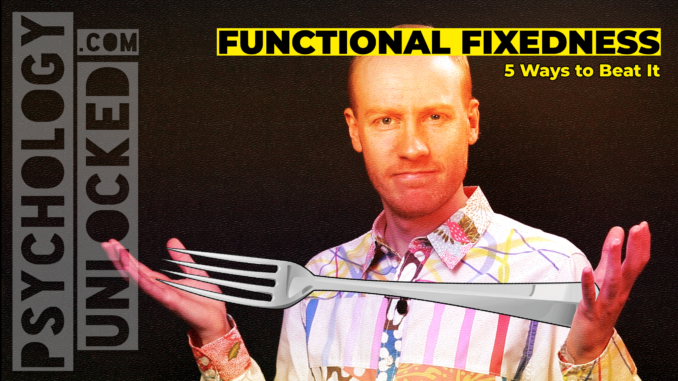
SCROLL DOWN FOR VIDEO
Cognitive biases are little unconscious tricks and shortcuts that our brain uses to help us make sense of the world.
Functional fixedness is one such example of a cognitive bias, in this case a bias for seeing the function of something as “fixed” on whatever the traditional use for that object is.
For a fork it’s eating. For a pen it’s writing. For a bike it’s cycling. But if we stop and consider for a moment, there are loads more things we could do with a fork, a pen, or a bike.
- The Dunning-Kruger Effect: Why we think we know more than we do
- The Yale Food Addiction Scale: Are you addicted to food?
- Addicted to Pepsi Max? Understand addiction in six minutes (video)
Our tendency to see the whole
The human brain has adapted to notice patterns and group things together, rather than see the individual parts.
This makes sense as an effective use of cognitive resources (easier to see one whole, than see 15 separate parts), and most of the time it doesn’t cause us any issues to perceive the world around us in this way.
But it does mean that we often miss out on the details of life, and can sometimes jump to conclusions based on incomplete information.
Optical illusions, such as the Kanizsa Triangle, demonstrate this phenomenon well – we can see a triangle, even though there isn’t a triangle in front of us. Our brain instinctively seeks out the pattern in the parts, and delivers us an entirely imaginary whole.

Cognitive Sets
A cognitive set is as similar concept to the, perhaps more familiar, “schema”.
“the predetermined way an individual construes a situation, which is based on a group of concepts, related to the self and other things, that determines an individual’s view of the world and influences his or her behaviour.”
APA Dictionary of Psychology
An easy way to visualise a “set” is to think of athletes running a race. If the starting whistle is blown without any warning, the athletes will run a slower race as they were unprepared.
However, if the athletes are given the opportunity to prepare for the start of the race, by someone saying “get set!”, then they will run a faster race.
The set has prepared them for a required response.
Functional Fixedness
Functional fixedness is, therefore, an example of a cognitive set, or cognitive bias.
The term was originally coined by Karl Duncker in 1945, and illustrated using an experimental set-up called The Candle Problem.
The Candle Problem
You have a candle, a box of pins, and some matches.
Your challenge is to connect the candle to a corkboard on the wall in such a way that you can still light the candle with the matches.
The solution is to empty the box of pins and pin that box to the corkboard. You can now use the box as a shelf. Place the candle on the shelf, and light it with the matches.
Duncker found that if participants were given the pins in the box, they found it difficult to see the alternative use for the box.
However, when partipants were given the box and pins separately (ie. an empty box and a loose pins) they were able to come to the solution with greater ease.
Five ways to tackle functional fixedness
1. Notice the cognitive bias
Noticing the bias allows you to force the decision making into the conscious parts of your brain, rather than the unconscious.
If a bias is unconscious it means you have no control over it. However, conscious thought, by its very nature, is something we can consciously control and manipulate.
Daniel Kahneman’s work on Thinking Fast and Slow is a great eye-opener on this point.
2. Look for alternative uses
One technique for challenging this cognitive bias is to deliberately challenge yourself to see beyond the typical function of an object.
Take one item each day and spend 5 minutes creating a list of as many alternative uses beyond the obvious function.
Here are some to get you started:
- Uses for a fork, beyond eating with it
- Uses for a sock, beyond wearing it
- Uses for a pen, beyond writing with it
- Uses for a sausage, beyond eating it
- Uses for a book, beyond reading it
Keep a record of how many alternatives you’re able to see within your 5 minutes, and over time you’ll see that you’re ability to engage in divergent thinking has developed.
3. See the parts, not the whole
One contributory factor in functional fixedness is that we see the whole, rather than the individual parts.
By breaking down an object into its finer details we are able to “re-see” it and this opens up new opportunities for how to use the object, either as a whole, or by separating it into smaller elements.
As above, take 5 minutes to focus in on the components of everyday objects, and see how far you can break them down. Start with larger objects and work your way up to the smaller ones, as you improve at this exercise.
Suggestions to start with:
- List all of the elements that together form a bed
- List all of the elements that together form a desk
- List all of the elements that together form a car
- List all of the elements that together form a computer
- List all of the elements that togther form a garden
4. Lateral Thinking Puzzles
Edward de Bono’s work on lateral thinking has been applied to business and educational settings since he developed the approach in the mid-late 20th Century.
A quick online search brings up some of his most famous lateral thinking puzzles, and he has published several books packed with puzzles to consider.
They are difficult, but once you get the idea of how they work they are also very fun.
5. Develop a Growth Mindset
Expanding from individual challenges to a life approach, Carol Dweck’s work on the Growth Mindset is a fantastic resource for developing a positive, flexible mindset to facilitate personal growth.
Her book, Mindset, is a great place to start and you’ll see improvements not just on individual problem solving, but in many facets of your life.
